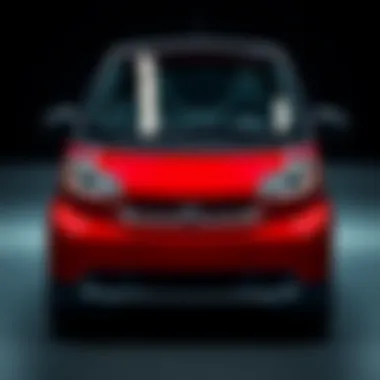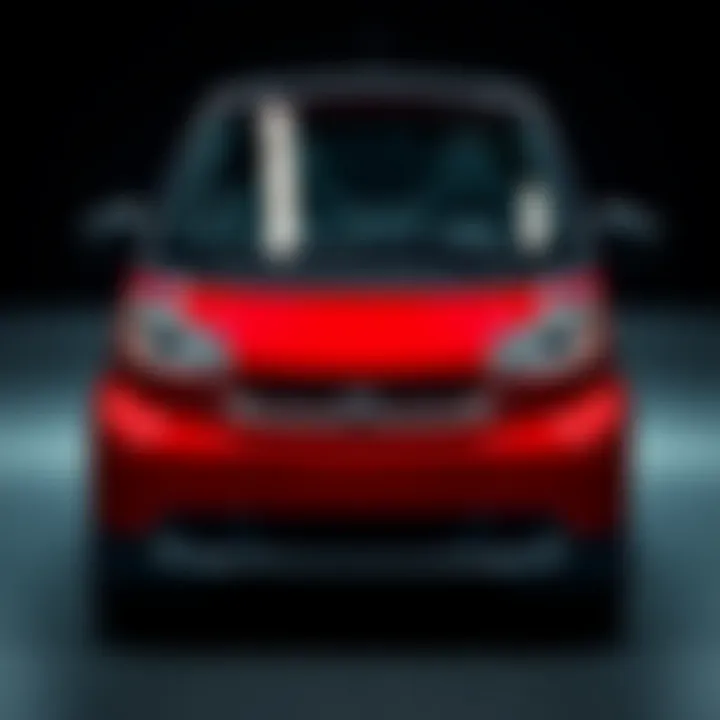Thorough Review of the 2009 Smart Car Engine


Intro
The 2009 Smart Car engine represents a unique blending of compact engineering and efficiency, characteristics that many urbanities require. As cities evolve, the demand for small, agile vehicles has surged. The Smart Car, specifically, has carved out a niche in this space, and understanding its engine is crucial for both potential buyers and automotive enthusiasts. This article will dissect the 2009 Smart Car engine in detail, exploring its performance, efficiency, design, and the overarching trends that have influenced its popularity.
Market Research Overview
Industry Trends and Insights
In recent years, automotive trends have showcased a stark shift towards sustainability and compactness. Small cars continue to gain traction, especially in densely populated urban settings where parking is at a premium. The trend is driven by various factors, such as increasing fuel prices and concerns about environmental impacts. In the context of these trends, the Smart Car engine made an indelible mark by emphasizing low emissions and commendable miles per gallon.
Furthermore, advancements in engine technology have brought turbocharging and direct injection to mainstreem small cars, including the Smart Car. This allows for an unprecedented balance between performance and efficiency. Brands are also leaning towards hybrid options, reflecting consumer preferences for greener alternatives.
Consumer Demographics
Understanding the consumer base that gravitates towards the Smart Car engine reveals much about modern motoring. Typically, the average owner of a Smart Car tends to be a city dweller, likely between the ages of 25 and 40, who values practicality over the traditional notions of luxury. It is common to find young professionals and environmental advocates in this group, keen on making choices that reflect their lifestyle and values. Moreover, buyers show an inclination towards vehicles that offer not just fuel efficiency but also adaptability in urban settings, characteristics that perfectly align with the Smart Car philosophy.
Reviews and Ratings
Detailed Product Breakdown
When reviewing the 2009 Smart Car engine, several metrics come into play. The engine boasts a 1.0-liter three-cylinder layout, delivering 70 horsepower with an automatic transmission. This configuration, while modest in power, speaks to its intended purpose: navigating city streets with ease. A few standout features of this engine include:
- Compact Size: The small engine provides ample space for passengers and luggage while ensuring the car remains lightweight.
- Fuel Efficiency: Achieving around 36 mpg in the city and 40 mpg on highways, the Smart Car engine stands out in its class.
- Environmentally Friendly: With lower emissions than many larger vehicles, the Smart Car engine caters to eco-conscious consumers.
Expert Review Summaries
Expert opinions tend to present a mixed bag when it comes to the 2009 Smart Car. Some reviewers praise it for its purpose-built engineering and efficiency, while others criticize its power output for those who prioritize speed. One expert noted:
"The Smart Car engine excels in city driving but may leave some wanting during highway merges. It's designed for small, tight spaces but lacks the excitement found in larger models."
Several platforms, including Reddit and Car and Driver, feature discussions and comparisons, showcasing user experiences and highlighting both the charms and quibbles of owning a Smart Car.
Preamble to the Smart Car
The undercurrents of urban transportation are in constant flux, and the Smart Car has carved a distinct niche for itself in this expansive market. Understanding the background of the Smart Car highlights not just its uniqueness but also its growing importance in the broader conversation about sustainability, micro-mobility, and urban planning. This section sets the stage by emphasizing the brand's mission and the essence behind its vehicles. During a time when large SUVs dominated the roads, the Smart Car emerged as a pragmatic alternative, balancing efficiency and environmental consciousness with a compact design perfectly fitting for bustling cityscapes.
Overview of Smart Car Brand
The Smart Car is a product of a collaboration between Mercedes-Benz and Swatch, aimed at creating a vehicle that could navigate the crowded streets of modern urban environments. Launched in the late 1990s, this brand epitomizes the shift towards smaller, eco-friendly cars that manage to deliver both style and functionality. The Smart brand promotes itself as not just a car, but a lifestyle choice that resonates with individuals seeking simplicity in a complex world.
Notably, the Smart Car operates on a philosophy of compactness, which transcends size to encapsulate efficiency in energy consumption and space utilization. This aligns closely with rising trends favoring smaller vehicles to counter traffic jams and parking limits that plague large cities.
Smart Cars are perfect for those who value the convenience of easy parking and maneuverability. Their design philosophy dovetails with sustainable living ideals, drawing environmentally conscious consumers who understand that smaller cars can lead to reduced emissions.
The Evolution of Smart Cars
The journey of the Smart Car is a fascinating one. It began as a response to an urgent need for environment-friendly, compact vehicles during a time when gas prices surged and congestion became a common experience in cities worldwide. The original Smart Fortwo introduced a fresh approach to automotive design, focusing on reducing the carbon footprint while maximizing the utility of space.
- Innovation: Each iteration of the Smart Car has introduced noteworthy innovations, from its distinctive shape to its economic performance. The 2009 model, in particular, represents a critical point in this evolution, combining features that catered directly to urban drivers.
- Market Changes: Amidst shifting market demands, Smart Cars have adapted, incorporating technological advancements while retaining the core attributes that made them appealing.
- Cultural Shift: As urban populations surged, the Smart Car also reflects a cultural shift toward valuing community and environmentally responsible choices.
Today, Smart Cars continue to evolve, integrating hybrid technologies and exploring electric options that align with a gently shifting automotive landscape. This adaptive quality plays a significant role in how potential buyers perceive the value of owning a Smart Car, especially in an era of increasing environmental awareness.
Ultimately, understanding the past informs how consumers gauge the Smart Car's future—a future filled with possibilities as they seek responsible transportation solutions. Through this lens, we can now observe the intricate details of the 2009 Smart Car engine, its specifications, and how it fits within the context of both the Smart brand and the evolving automotive industry.


Engine Specifications of the Model
Understanding the engine specifications for the 2009 Smart Car is crucial for anyone looking at this compact marvel. These specifications do not just define how the vehicle performs on the road; they also indicate the underlying technology that drives efficiency and innovation. Let's explore the critical components that make up the engine of this city-friendly car. Each aspect plays a pivotal role in determining everything from the car's responsiveness to its reliability.
Engine Type and Design
The engine for the 2009 Smart Car showcases a thoughtfully engineered design aimed at maximizing efficiency. It employs a three-cylinder inline engine configuration, which might sound humble but brings a pleasant surprise regarding performance. This design minimizes complexity and weight, allowing for higher fuel efficiency while maintaining a sprightly nature.
A focal point of the design is its turbocharging capability. This feature not only enhances power output but also does so while keeping emissions lower than many traditional engines. As the car zips through urban landscapes, it demonstrates a blend of engineering prowess and environmental consideration, perfect for city dwellers. Moreover, a compact engine aids in optimizing the vehicle's overall dimensions, attracting those who thrive in tight parking spaces.
Displacement and Cylinders
When it comes to specifications, displacement is one of those numbers that enthusiasts often scrutinize. The 2009 Smart Car's engine boasts a displacement of just 0.8 liters, which firmly places it in the small-engine category. This small displacement may raise eyebrows, however, it’s essential to note that it works in tandem with turbocharging, enabling it to generate adequate power without guzzling fuel.
The three-cylinder setup typically allows for efficient fuel consumption while also producing a unique sound that some drivers may find distinctive, to say the least. Pairing a minimal displacement with a straightforward cylinder arrangement sets the Smart Car apart, transforming it from a mere city runabout to a practical vehicle for daily use in urban settings.
Horsepower and Torque Ratings
Diving into the power metrics, the 2009 Smart Car's engine produces a respectable 70 horsepower and 68 lb-ft of torque. While these numbers might seem low compared to larger vehicles, they are adequate for city driving scenarios. The engine’s torque delivery, available at lower RPMs, provides that initial pull needed for quick starts at traffic lights or navigating bustling neighborhoods.
It is interesting to observe how these ratings contribute to the overall driving experience. Drivers often report a smooth pull away from rest, granting an impression of nimbleness, despite horsepower figures that might otherwise raise skepticism. This is a classic example of how thoughtful engineering can redefine expectations in the automotive sector.
"A smaller engine doesn't mean a lack of excitement; it simply redefines the boundaries of what performance can look like."
In summary, the engine specifications of the 2009 Smart Car reflect a pragmatic approach to vehicle design. The combination of a compact yet capable engine, low displacement, and smart engineering choices helps it stand out in a crowded market. It caters effectively to the needs of urban drivers while also boasting an environmentally considerate profile.
Performance Metrics
Performance metrics serve as the backbone for assessing a vehicle's capability and efficiency, particularly when analyzing the 2009 Smart Car engine. This section zeroes in on critical indicators such as acceleration, fuel economy, and environmental impact, all of which delineate how well the Smart Car operates in comparison to other vehicles in the microcar segment. Understanding these metrics allows potential buyers and enthusiasts to make informed choices based on real-world data and performance expectations.
Acceleration and Speed
The 2009 Smart Car is distinctive primarily due to its compact size and lightweight build, a trait that significantly impacts its acceleration. While it might not win any drag races, the Smart Car’s design offers a unique perspective on urban driving. The engine can propel from 0 to 60 mph in around 12 seconds, which is respectable for city maneuvering. When you consider its small footprint, this characteristic becomes less about raw power and more about efficient urban navigation.
This aspect, while often undervalued, is crucial for city drivers who frequently engage in stop-and-go situations. The ability to zip through traffic without feeling sluggish can make a world of difference. With a top speed of about 90 mph, the 2009 Smart Car manages to balance speed and safety, positioning itself effectively within the microcar category.
Fuel Efficiency Ratings
Fuel efficiency remains a pillar of attraction for small vehicles, and the 2009 Smart Car boasts impressive figures. It averages approximately 40 miles per gallon on the highway and about 33 mpg in city driving conditions. This thrifty consumption not only leads to reduced fuel expenses but also lessens the environmental toll of driving. In a world increasingly concerned with sustainability, these figures can capture the attention of conscientious buyers.
In addition, users frequently praise the Smart Car for its ability to stretch a gallon of gas. This translates into fewer trips to the gas station—a convenience that urban dwellers especially appreciate, given often high fuel prices in metropolitan areas. The Smart Car’s fuel efficiency is a significant selling point, reaffirming its image as a smart choice in the crowded vehicle market.
Emissions and Environmental Impact
As automotive technology continues to evolve, so does the emphasis on reducing emissions. The 2009 Smart Car, with its modest engine size, manages to keep CO2 emissions to about 120 grams per kilometer, positioning it favorably against bigger cars. This low emission rating underscores the Smart Car's commitment to environmental considerations, making it an attractive option for eco-conscious drivers who seek out green vehicle alternatives.
In a nutshell, the 2009 Smart Car presents itself as not just a good choice for individuals seeking a compact vehicle for urban environments, but also as a responsible choice for those looking to lessen their carbon footprint.
"The compact design paired with fuel efficiency makes the Smart Car a wise choice for eco-conscious consumers in bustling cities."
In summary, performance metrics provide a holistic view of the Smart Car's capabilities. By evaluating acceleration, fuel efficiency, and emissions, one can see how the 2009 Smart Car is tailored to meet the demands of urban driving while simultaneously addressing pressing environmental issues.
Technological Features


The 2009 Smart Car engine isn't just a marvel of compact engineering; it stands at the intersection of innovation and practicality. Understanding the technological features of this vehicle is crucial for prospective buyers and enthusiasts who seek both performance and efficiency. Various key elements contribute to the Smart Car's cultural appeal and mechanical effectiveness, encompassing engine management systems, transmission options, and unique design elements that underline its purposeful aesthetic.
Engine Management Systems
Engine management systems within the 2009 Smart Car play a pivotal role in regulating the engine's performance. These systems are sophisticated, ensuring an optimal balance between power output and fuel efficiency. The Electronic Control Unit (ECU), often dubbed the brain of the car, oversees critical parameters. It adjusts fuel injection rates and ignition timing based on real-time data gathered from various sensors, such as the throttle position sensor and air mass flow sensor. This dynamic adjustment not only enhances engine responsiveness but also contributes significantly to overall fuel economy.
In practical terms, drivers benefit from smoother acceleration and improved engine longevity. With features like these, one can see how Smart engineers aimed to provide an experience that resonates with both urban dwellers and eco-conscious users seeking smart mobility solutions.
Transmission Options
Transmission options can make or break the driving experience, especially in a compact vehicle like the Smart Car. The 2009 model offers a five-speed automated manual transmission, which merges the clutch action of a manual system with the ease of an automatic. This system allows for rapid, smooth gear changes – a delightful requirement for city driving where stop-and-go traffic reigns supreme.
This unique setup separates the Smart Car from traditional automatics or manual gearboxes, giving drivers an innovative way to engage with their vehicle. Given how many urban drivers prioritize ease over complexity, this transmission option hits the nail on the head. Additionally, the compact size of the Smart Car benefits greatly from such transmission technology, optimizing the engine's output at all speeds, which is vital when maneuvering through tight city streets.
Innovative Design Elements
The Smart Car's design isn't merely a quirk; it emphasizes functionality and efficiency. One of its standout innovations is the tridion safety cell. This unique structure is made from high-strength steel, designed to absorb the impact of collisions while keeping passengers safe. The engine placement, located at the rear, shifts weight distribution in a way that enhances stability. It's an interesting approach—one that most drivers might overlook at first but is essential for handling and safety.
Beyond structure, the engine's design emphasizes services, especially in urban settings. The overall compact design redefines the concept of mobility. The smaller size allows for easier parking—an enviable asset in crowded cities. Add to that the environmental focus with the low emissions engine, and the 2009 Smart Car isn't just built for the here and now; it aligns with future transport trends.
"The Smart Car transcends its size, performing as an adept urban vehicle while highlighting advanced engineering innovations that cater to contemporary automotive needs."
Comparative Analysis with Competitors
A comparative analysis against competitors is vital to understanding the true value of the 2009 Smart Car engine. By contrasting its specifications and features with similar microcars, potential buyers can navigate through the dense forest of available choices. This section sheds light on not just the raw numbers, but also customer experiences and perceptions that shape market dynamics.
Benchmarking Against Other Microcars
When assessing the 2009 Smart Car, it becomes crucial to gauge its performance against its peers in the microcar segment. Notable competitors include the Toyota iQ and the Fiat 500, both of which have made their mark with distinctive attributes. The benchmarking process usually involves examining key performance indicators such as fuel economy, engine power, and maneuverability.
For instance, the Toyota iQ boasts impressive fuel efficiency, clocking in around 36 miles per gallon in city driving. In contrast, the Fiat 500, with its retro styling, offers a selection of peppy engines that appeal to a different segment of buyers, demonstrating a blend of style and practicality.
However, the Smart Car’s micro-dimensions allow it to easily slip through narrow urban corridors, an advantage not as readily available to its competitors. The Fiat 500 might be a charmer, but its slightly bulkier size can make it cumbersome in tight spots. Thus, while raw numbers present a favorable picture for competitors, real-world usability tilts things back in favor of the Smart Car in urban settings.
"In many compact urban environments, the ability to maneuver is priceless – that’s the Smart Car’s undeniable ace in the hole."
Key Points of Comparison
- Fuel Efficiency: Smart Car is often praised for its ability to maximize fuel economy, making it ideal for city driving.
- Engine Power: While competitors like the iQ offer different engine packages, the Smart Car's engine gives just enough poke for its intended use; it doesn’t aim to roar but rather hum along softly.
- User Experience: Feedback often highlights the comfort within city limits, which can be a decisive factor for potential buyers.
Ultimately, when comparing the 2009 Smart Car to its peers, it becomes clear that buyers need to consider their specific driving needs. Horsepower and torque might matter on open highways, but for city dwellers, maneuverability and fuel efficiency take precedence.
Market Positioning in
In 2009, the Smart Car was positioned as not just a vehicle but rather a lifestyle choice. Advertising campaigns targeted urban professionals and eco-conscious buyers alike, tapping into a growing desire for smaller, efficient cars. The 2009 model specifically targeted singles or couples living in metropolitan areas, and it championed itself as an answer to parking woes.
Buyers in that era were increasingly concerned about environmental impact, and the Smart Car's low emissions resonated with this demographic. It articulated a philosophy that less is more – less space, less hassle, and ultimately, less ecological footprint.
While its sales numbers might not have set the world on fire, the marketing achieved what it aimed at - establishing a niche for the Smart Car brand. It carved out a section of the market for those looking to adopt greener habits without sacrificing mobility, positioning itself against larger brands like Ford and Honda that dominated the compact car market but with little focus on micro-vehicles.
Moreover, reviews highlighted a mix of admiration and skepticism. Some praised it as innovative, while others questioned its long-term viability. However, the creative marketing strategies developed around its eco-friendly qualities ensured that the Smart Car maintained adequate visibility, allowing it to hold its ground against larger, more established competitors.
In essence, the 2009 Smart Car fitted snugly within an emerging market for stylish yet functional urban vehicles. As it stood against competition, it appealed not just to drivers but to a burgeoning community valuing sustainability and efficient city living.


User Reviews and Feedback
Understanding user reviews and feedback is essential when analyzing the 2009 Smart Car engine. These voices highlight real-world experiences that go beyond technical specifications. They offer insights into the vehicle's reliability, performance under various conditions, and how the engine meets everyday needs. For potential buyers, reviews can illuminate the shortcomings that manufacturers may not readily disclose. Moreover, feedback from existing users serves as a barometer for satisfaction levels, ultimately influencing purchasing decisions.
Common Praises and Criticisms
User evaluations of the 2009 Smart Car engine often reveal a mixed bag, showcasing fervent supporters alongside critical voices. On one hand, many users sing praises about the vehicle’s fuel efficiency, often citing as high as 40 miles per gallon in city driving. This aspect aligns nicely with the ecological trend of the late 2000s while proving economically beneficial for individuals with tight budgets. Additionally, the compact size of the Smart Car also garners commendation as it facilitates easy parking in crowded urban locales, allowing drivers to navigate through tight spots with relative ease.
However, not all reviews sparkle with positivity. A consistent criticism raises concerns about power — or the lack thereof. Many drivers report that, especially on highways, the car struggles with acceleration during merges or overtakes. A handful of them have referred to it as feeling ‘overwhelmed’ when confronted with fast-moving traffic, thus echoing a shared feeling of insecurity on busy roads. Furthermore, users indicate a cramped interior, often suggesting that taller individuals might find the seating uncomfortable during prolonged drives.
“It’s like driving a zippy little rollercoaster! Fun for short trips, but that engine has its limits on the highway.”
— Anonymous review from an automotive enthusiast.
Long-term User Experiences
Turning to long-term ownership experiences provides an even richer tapestry of insights regarding the 2009 Smart Car engine. Many owners who took the plunge express satisfaction with the engine's durability over the years. A surprising number of users report few major issues even after several years of daily use, contributing to positive feelings about the vehicle's reliability.
Nonetheless, long-term drivers also note that regular maintenance is key to sustaining performance. There's a general consensus that routine oil changes and attention to engine systems can help mitigate minor degradation issues that might arise.
Social media platforms, such as Reddit, have communities devoted to sharing such experiences. From personal anecdotes detailing journeys of ‘X’ miles without serious engine problems to cautionary tales regarding lack of power, these user insights are invaluable for gauging what life with a 2009 Smart Car engine really looks like. Owners often suggest that despite the limitations, the vehicle rewards its drivers with a distinct character and quirky charm, making it a beloved option in the microcar segment.
Overall, user reviews and feedback form a vital component in comprehending the 2009 Smart Car engine. The blend of praise and criticism helps future buyers craft expectations and make informed choices regarding their small vehicle alternatives.
Future Outlook for Smart Cars
The landscape of urban transportation is evolving rapidly, and Smart Cars are positioned at the cutting edge of these changes. It's crucial to examine where these vehicles are headed, particularly in the wake of global shifts toward sustainability and technological innovation. As cities grapple with congestion and pollution, the demand for efficient, eco-friendly transportation solutions is rising sharply. Smart Cars, with their compact size and efficiency, are ideally suited for this new environment, making their future outlook not just interesting, but necessary for the automotive industry.
Trends in Electric and Hybrid Technology
The push for electric and hybrid vehicles is fundamentally reshaping the automotive market. This trend stems from growing environmental concerns, rising fuel costs, and governmental policies aimed at reducing carbon emissions. For Smart Cars, the integration of electric and hybrid powertrains offers multiple advantages:
- Environmental Impact: With zero emissions at the tailpipe, electric models contribute significantly to cleaner air in urban settings.
- Cost Efficiency: Although initial prices for electric vehicles can be higher, lower running costs due to decreased fuel consumption and less maintenance can make them more economical in the long run.
- Consumer Appeal: As more consumers become environmentally conscious, the appeal of hybrid and electric Smart Cars grows, potentially opening new markets.
For instance, recent advancements in battery technology have enhanced the range and performance of electric models, making them more appealing to a broader audience. As this trend continues, expect Smart to innovate further, manufacturing vehicles that are not only smaller but equipped with cutting-edge technology that promotes sustainability without compromising performance.
Potential Development in Future Models
Looking ahead, the potential for development in future Smart Car models is promising. The challenges and opportunities presented by current market trends beckon innovative solutions. Here are a few areas where Smart could focus its efforts successfully:
- Smart Connectivity: As vehicles integrate more with smart technology, future models could offer enhanced connectivity, allowing drivers to sync their vehicles with smart home systems or mobile devices seamlessly.
- Autonomous Driving Features: With advancements in technology, incorporating semi-autonomous features could revolutionize the way Smart Cars operate in urban environments. These innovations could enhance safety and efficiency in crowded conditions.
- Customization Options: The growing trend towards personalized vehicles could lead Smart to offer more configurable options to cater to individual consumer preferences.
"The future of Smart Cars hinges on their ability to adapt to the rapidly changing demands of consumers and environmental standards."
The End
The conclusion serves as the final capstone of our exploration into the 2009 Smart Car engine, bringing together various threads from earlier discussions. It's not just a simple wrap-up; it is an opportunity to reinforce understanding and highlight the impact of the findings presented. The key is to reaffirm the significance of the engine's design, performance, and user reviews, which collectively create a fuller picture of the Smart Car experience.
Summary of Key Findings
Throughout this article, several pivotal insights have emerged:
- Engine Specifications: The 2009 model boasts a compact yet efficient engine design, specifically a 0.8-liter turbocharged engine that caters well to urban environments.
- Performance Metrics: With modest acceleration capabilities, the engine allows for quick maneuverability in crowded city streets, striking a balance between speed and fuel efficiency.
- Technology Integration: Not only does the Smart Car feature a robust engine management system, but it also embraces seamless transmission options, contributing to a smoother overall drive.
- User Feedback: The general consensus among users leans towards appreciation of the car’s efficiency, while also noting drawbacks such as limited space and engine noise during acceleration.
In short, the 2009 Smart Car engine stands out for its unique place in the automotive realm, particularly appealing to eco-conscious urban drivers seeking practicality.
Final Thoughts on the Smart Car Engine
In closing, the 2009 Smart Car engine represents an intriguing blend of innovation and practical design, sculpted with city dwellers in mind. The discussion highlights not only the technical specifications but also how consumer experiences shape overall perception. As we look to the future of transportation, the strides made by Smart Cars can serve as an emblem of evolving automotive engineering, illuminating pathways for burgeoning technologies in electric and hybrid vehicles.
Understanding the nuances of such vehicles is key for consumers striving to make informed choices in a rapidly changing market. The Smart Car engine, with all its character and quirks, does not merely transport; it opens a door to new perspectives in sustainable driving. Finally, while the Smart Car may have its limitations, it undoubtedly paves the way towards more innovative solutions that lie ahead.







